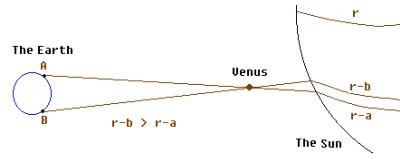
How to measure the distance between the Earth and the Sun?
Acording to the third Kepler’s law (T12/a13 = T22/a23), which compares orbital times and the planets distances from the Sun, we can count the distances ratio of individual space objects of the Solar system in the way that T12 and a13 equals 1 (The Earth orbits the Sun in one year and the distance of the Earth from the Sun becomes the basis of AU) and we come to a simple equation T2 = a3.
And then the only information we need to know is the orbit period of the planet whose distance we want to know. For example Venus responds 0,73 AU which means that its orbit is one third shorter than the Earth orbit.
If we need to know something more than only the distance in ratio but also in numbers, then it is necessary to define the Sun parallax. That`s not an easy thing, because it would remind the effort of defining angles of the triangle basis limited by one crown coin and a matematician standing in the distance of 243m. The Venus transit can help us. The first one who studied the possibility of measuring the distance between the Earth and the Sun in the time of Venus transit, was Edmond Halley. His theory is based on the fact that two observers standing as far as possible from each other can see the transit under a different angle. For the Venus transit on June 8th 2004 holds true that the more south the observer is, the longer the event takes. We can have an idea from the following picture:

The way of calculation
Distance r-a and r-b is calculated from observing the four moments of contacts of Venus and the Sun discs observed on two different places of the Earth. The difference in the angle between centres of those chords determines the angle σ. The parallax π is then determined this way:
π = [D / (A - D)] σ /D - distance
of Venus and A - of the Earth From the Sun/
tg π = Rz/A => A = Rz/tg π /π - parallax,
Rz - radius of the Earth, A - AU/
We in the Venus transit 2004 project
| c. | Time (UTC) | AU (km) | Π (") | Δ AU (km) | Δ Π (") | Error |
|---|---|---|---|---|---|---|
| 1. | 05 h 20 m 31 s | 149907105 | 8.776O | 309235 | 0.0181 | 0.207% |
| 2. | 05 h 39 m 05 s | 149398558 | 8.8O59 | 199312 | 0.0117 | 0.133% |
| 3. | 11 h 03 m 37 s | 149633179 | 8.792O | 35309 | 0.0021 | 0.024% |
| 4. | 11 h 22 m 57 s | 149614693 | 8.793O | 16823 | 0.0010 | 0.011% |
Real AU = 149597870 km
Our results:
- Ø AU = 149638384
- Ø Π = 8,7918 "
- Ø error = 0,027 %
Graph of our results:
